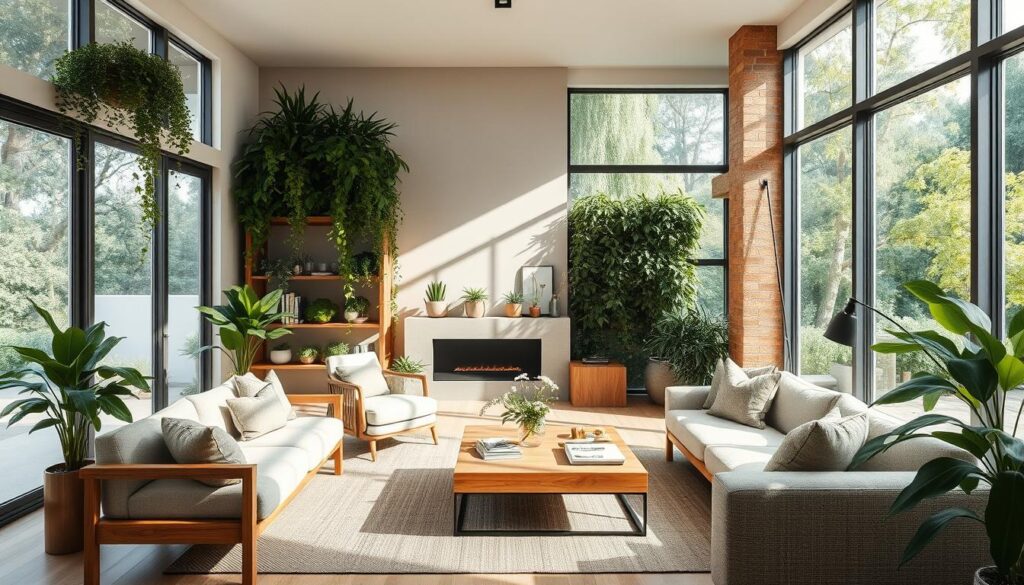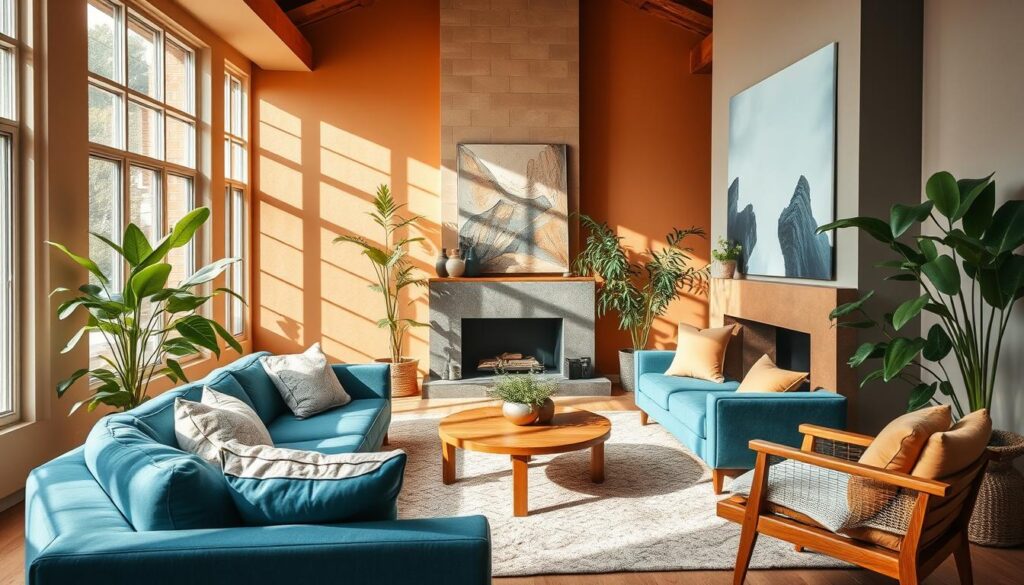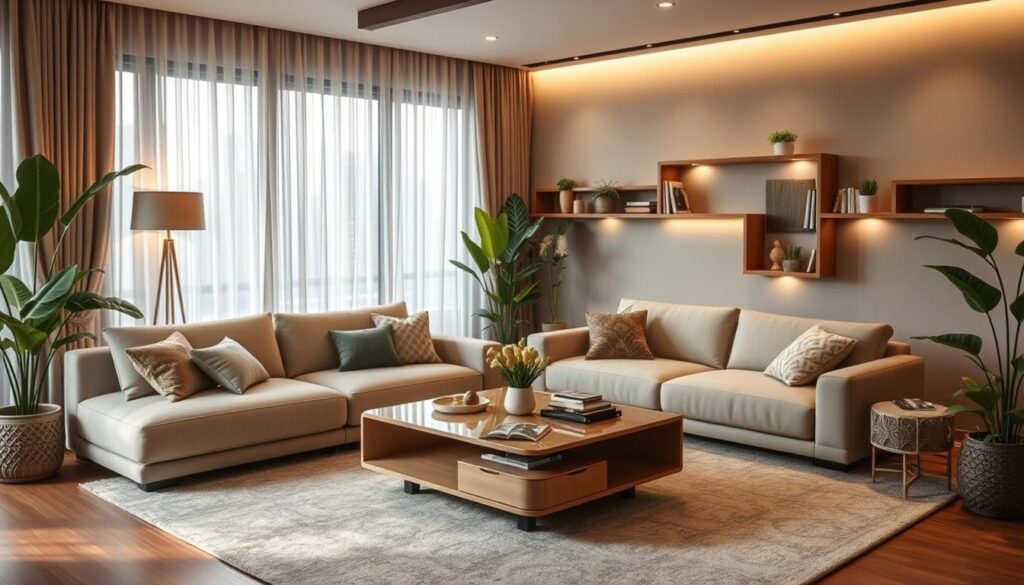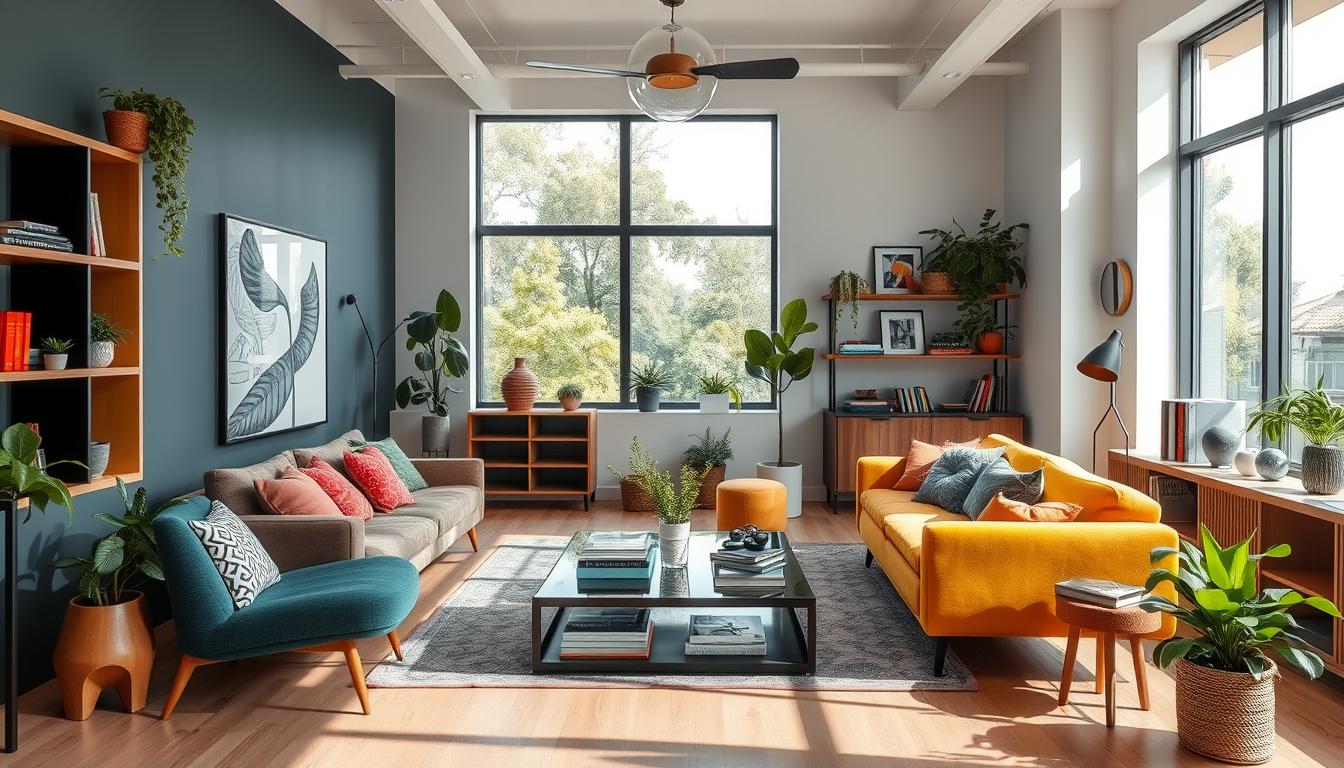Imagine a living space that not only looks visually stunning but also functions seamlessly to enhance your daily life. This is the promise of creative interior design solutions – the art of transforming your home into a sanctuary that truly reflects your personal style and lifestyle. In a world where our living environments have a profound impact on our well-being, it’s time to uncover the power of innovative design.
Did you know that strategically curated interiors can boost your mood, increase productivity, and even inspire creativity? It’s time to challenge the notion that design is just about aesthetics. Join us as we explore the captivating world of creative interior design solutions and discover how they can transform your space into a harmonious and functional oasis.
Key Takeaways
- Interior design goes beyond just aesthetics – it can enhance your overall well-being and productivity.
- Innovative design solutions can breathe new life into your living space, making it both visually appealing and highly functional.
- Explore the art of balance, proportion, and color theory to create a harmonious and captivating interior.
- Discover how to incorporate nature, technology, and personalization into your design for a truly customized space.
- Gain insights from real-life case studies and expert tips on working with interior designers.
Introduction to Creative Interior Design Solutions
At the heart of any remarkable living space lies thoughtful interior design. Far more than mere aesthetics, design has the power to transform our daily lives, elevating our moods and even impacting the overall value of our properties. In this section, we’ll explore the significance of design and delve into the myriad benefits of adopting creative solutions for your home.
Why Design Matters
Interior design is not simply about creating a visually appealing environment. It’s a strategic process that considers the interplay of function, comfort, and personal expression. Well-designed spaces can have a profound influence on our mindset, productivity, and overall well-being. By incorporating sustainable design concepts and space optimization techniques, we can create living spaces that are not only beautiful but also truly harmonious with our lifestyle needs.
The Benefits of Creative Solutions
- Increased property value: Innovative design choices can significantly enhance the market value of your home, making it a worthwhile investment.
- Improved mood and productivity: Thoughtfully curated spaces can uplift your mood, reduce stress, and foster a more focused, productive environment.
- Enhanced functionality: Creative solutions, such as multifunctional furniture and zoning for different activities, allow you to maximize the potential of your living space.
- Sustainability and energy efficiency: Integrating sustainable design concepts can reduce your carbon footprint and lead to long-term cost savings.
By embracing the power of creative interior design, you can transform your living space into a harmonious haven that reflects your unique style and enhances your overall quality of life.
“Great design is about creating spaces that inspire us, that make us feel good, that help us live better.” – Nate Berkus, American interior designer
Key Principles of Interior Design
Crafting captivating interior spaces requires a deep understanding of the fundamental principles that govern design. From balance and harmony to scale, proportion, and color theory, these elements work together to create visually striking and harmonious environments. Let’s delve into the key principles that shape modern color psychology in interiors and modern decor trends.
Balance and Harmony
The concept of balance is crucial in interior design, ensuring that a space feels visually stable and cohesive. Whether it’s through symmetrical arrangements or the careful placement of focal points, maintaining a sense of equilibrium can elevate the overall aesthetic. Harmony, on the other hand, refers to the seamless integration of various design elements, creating a sense of visual unity and flow throughout the space.
Scale and Proportion
The interplay of scale and proportion plays a vital role in creating visually appealing interiors. Carefully considering the size and scale of furniture, artwork, and other decor items in relation to the room’s dimensions can significantly impact the perceived feel and functionality of a space. Striking the right balance between these elements can transform a room from ordinary to extraordinary.
Color Theory
The psychology of color and its impact on interior design cannot be overstated. From soothing neutrals to bold, vibrant hues, the strategic use of color can evoke specific moods, emotions, and even influence the perceived size and depth of a room. Understanding color psychology in interiors and how to effectively incorporate modern decor trends is a key skill for any designer.
“Color is a power which directly influences the soul.” – Wassily Kandinsky
By mastering these fundamental principles of interior design, you can unlock the full potential of your living spaces, creating environments that are not only visually stunning but also deeply meaningful and functional.
Innovative Space Planning Techniques
In the pursuit of maximizing the potential of any living or workspace, interior designers have developed a arsenal of innovative space planning techniques. From open concept layouts to multi-functional furniture solutions, these strategies can transform even the most cramped quarters into functional, comfortable, and visually captivating environments.
Open Concept Layouts
The open concept design approach has gained immense popularity in recent years, as it allows for a seamless flow between different zones within a space. By strategically removing walls and barriers, homeowners can create a sense of openness and airiness, making even smaller homes feel more expansive and inviting. This layout style also facilitates natural light penetration and enhanced visual connectivity, fostering a greater sense of spaciousness.
Multifunctional Furniture
In the age of space optimization techniques, multi-purpose furniture has emerged as a game-changer. Pieces like convertible sofas, storage ottomans, and transforming coffee tables enable homeowners to pack more functionality into their homes without sacrificing valuable square footage. These custom furniture ideas not only maximize the utility of a space but also lend a unique, personalized touch to any interior design scheme.
Zoning for Different Activities
Effective space planning also involves the strategic zoning of various activities within a room or open-concept layout. By designating specific areas for work, leisure, and other functions, designers can create a harmonious and efficient flow, ensuring that each zone serves its intended purpose without feeling cluttered or chaotic. This approach helps to minimize visual distractions and enhances the overall functionality of the space.
From open-concept living to multifunctional furniture and purposeful zoning, innovative space planning techniques offer a wealth of opportunities to transform even the most challenging interiors into exceptional, customized environments. By embracing these design strategies, homeowners can unlock the full potential of their living spaces and create truly remarkable, personalized havens.
How to Incorporate Nature in Design
Embracing the beauty and serenity of the natural world within our interior spaces can have a profound impact on our well-being and the overall sustainability of our living environments. By incorporating biophilic design principles and leveraging the power of sustainable design concepts, we can transform our homes and workspaces into sanctuaries that nourish our senses and our connection to the earth.
Biophilic Design Principles
Biophilic design is a holistic approach that seeks to integrate elements of nature into the built environment. This can be achieved through the strategic placement of indoor plants, the incorporation of natural materials, and the optimization of natural light. By incorporating these elements, we can create spaces that foster a sense of calm, enhance cognitive function, and support overall mental and physical health.
Indoor Plants as Decor
- Strategically placed indoor plants can purify the air, reduce stress, and boost productivity.
- Choose a variety of plants, from low-maintenance succulents to lush, trailing vines, to create a vibrant and ever-changing display.
- Group plants together to create a lush, natural feel, or use them as statement pieces to anchor a room’s design.
Natural Light Optimization
Harnessing the power of natural light can have a transformative effect on a space. By maximizing the use of windows, skylights, and other light-enhancing features, we can create bright, airy environments that feel connected to the outdoors. Not only does this improve the overall aesthetic, but it also has been shown to have a positive impact on mood, sleep, and energy levels.
| Biophilic Design Benefits | Sustainable Design Benefits |
|---|---|
| Improved mental and physical well-being | Reduced energy consumption and carbon footprint |
| Enhanced cognitive function and productivity | Increased use of renewable and eco-friendly materials |
| Stronger connection to the natural world | Improved indoor air quality and overall environmental impact |
By embracing the principles of biophilic design and sustainable design concepts, we can create interior spaces that not only look beautiful but also nourish our bodies, minds, and the planet we call home.

Utilizing Technology in Interior Design
In today’s digital age, technology has revolutionized the way we approach interior design. Smart home integration, virtual reality visualizations, and sustainable tech solutions are transforming the landscape of modern living spaces. These innovative tools not only enhance functionality but also promote eco-friendly and energy-efficient design concepts.
Smart Home Integration
The integration of smart home systems has made it easier than ever to manage and control various aspects of our living environments. From automated lighting and climate control to voice-activated appliances and security features, smart home technology offers a seamless and convenient way to optimize both comfort and efficiency. By harnessing the power of interconnected devices, homeowners can create personalized, energy-saving environments that cater to their unique preferences.
Virtual Reality for Visualization
Virtual reality (VR) has become an invaluable tool for interior designers and homeowners alike. With VR-based design software, it’s possible to visualize and experience a space before it’s even been constructed. This technology allows for a more immersive and interactive design process, enabling users to experiment with different layouts, color schemes, and furnishings, ultimately leading to more informed and satisfying design decisions.
Sustainable Tech Solutions
Sustainable design concepts are gaining traction, and technology plays a crucial role in supporting eco-friendly practices. From energy-efficient smart appliances and LED lighting to innovative materials and renewable energy sources, sustainable tech solutions are helping to reduce the environmental impact of interior spaces. By embracing these advancements, homeowners can create living environments that are not only visually appealing but also environmentally responsible.
| Technology | Benefits |
|---|---|
| Smart Home Integration |
|
| Virtual Reality for Visualization |
|
| Sustainable Tech Solutions |
|
By embracing the power of technology, interior designers and homeowners can create living spaces that are not only visually stunning but also intelligent, eco-conscious, and tailored to their unique needs and preferences. These advancements in smart home integration and sustainable design concepts are redefining the way we think about and experience our living environments.
Color Trends and Their Impact
In the ever-evolving world of modern decor trends, color plays a vital role in shaping the ambiance and mood of any interior space. From calming palettes to vibrant hues, the color psychology in interiors can significantly influence our perceptions and emotions.
Current Color Trends
The recent years have witnessed a surge in the popularity of soothing and natural tones, such as earthy greens, soft blues, and warm neutrals. These colors create a sense of tranquility and harmony, reflecting the growing desire for sanctuary-like spaces in our homes.
How to Choose the Right Palette
- Consider the overall aesthetic and mood you want to achieve in the space.
- Utilize color theory to balance complementary or analogous hues.
- Experiment with bold accents and pops of color to add visual interest.
- Incorporate natural elements, such as plants or wooden textures, to enhance the color scheme.
The Psychology of Color
Color has a profound impact on our emotions and perceptions. Blue tones can evoke a sense of calmness and serenity, while red hues can stimulate energy and passion. Understanding the psychological effects of color is crucial in creating spaces that cater to the wellbeing and mood of the occupants.
“Color is a power which directly influences the soul.” – Wassily Kandinsky

By embracing the current color trends and leveraging the power of color psychology in interiors, designers and homeowners can transform their spaces into visually captivating and emotionally resonant sanctuaries.
Textures and Materials: The Design Layer
In the realm of interior design, the interplay of textures and materials is a captivating dance that elevates the space beyond mere aesthetics. From the artisan craftsmanship of luxurious fabrics to the tactile allure of durable surfaces, these design elements create a sensory experience that can truly transform a room.
Combining Different Textures
Mastering the art of blending contrasting textures is a hallmark of exceptional design. A plush velvet sofa paired with a sleek glass coffee table, or a rustic wooden accent wall complemented by smooth marble countertops – these combinations create a visually striking and harmonious environment. By juxtaposing soft and hard, rough and smooth, designers can inject depth, dimension, and a sense of luxury design inspirations into any space.
The Role of Fabrics
- Fabrics serve as the canvas upon which a room’s personality is painted.
- Luxurious textiles like silk, cashmere, and linen can infuse a space with an air of refinement and sophistication.
- Durable materials like cotton and microfiber offer practicality and longevity, making them ideal for high-traffic areas.
- Carefully selected fabrics can also enhance the overall ambiance, from the cozy warmth of a plush throw to the airy elegance of sheer curtains.
Material Selection for Durability
When designing a space, it’s crucial to strike a balance between form and function. Artisan craftsmanship in materials like solid wood, natural stone, and high-quality metals not only elevates the aesthetic but also ensures the longevity of the design. Investing in luxury design inspirations that withstand the test of time can create a timeless and sustainable interior that will continue to captivate for years to come.
| Material | Durability | Maintenance | Aesthetic Impact |
|---|---|---|---|
| Solid Wood | High | Moderate | Warm, natural, and timeless |
| Natural Stone (Granite, Marble, Quartz) | Very High | Moderate to High | Luxurious, elegant, and versatile |
| High-Quality Metals (Stainless Steel, Brass, Iron) | Extremely High | Low | Sophisticated, modern, and industrial-chic |
“The devil is in the details, and when it comes to interior design, the textures and materials we choose are the foundation upon which we build our dream spaces.”
Customization and Personalization
In the ever-evolving world of creative interior design solutions, the power of customization and personalization cannot be overstated. By tailoring designs to your unique needs and preferences, you can transform your living space into a true reflection of your style and personality. From custom furniture ideas to the integration of ethnic and cultural influences, the possibilities are endless when it comes to creating a personalized sanctuary.
Tailoring Designs to Your Needs
No two individuals are alike, and your interior design should be a testament to your unique lifestyle and preferences. Whether it’s a custom-built shelving unit to maximize storage or a bespoke seating arrangement that caters to your entertainment needs, the key is to work closely with your designer to bring your vision to life.
Unique Art and Accessory Choices
Elevating your space with one-of-a-kind art pieces and carefully curated accessories can instantly add a touch of personality and character. Explore local artisan markets, vintage shops, or collaborate with independent artists to find captivating works that truly resonate with you. These unique additions can become the centerpieces that tie your entire interior design together.
Ethnic and Cultural Influences
Embracing the rich tapestry of diverse cultures can infuse your home with a sense of global sophistication. Incorporate textiles, furniture, or decorative elements that reflect your heritage or the places you’ve traveled, creating a space that is not only visually stunning but also a meaningful expression of your identity.
By leveraging the power of custom furniture ideas and creative interior design solutions, you can craft a space that is entirely your own, a sanctuary that celebrates your individuality and inspires you every day.

Case Studies of Creative Solutions
Unlocking the true potential of your living space often requires a creative and innovative approach to interior design. In this section, we’ll explore real-life case studies that showcase transformative before-and-after examples, homeowner success stories, and valuable lessons learned from various design projects.
Transformative Before-and-After Examples
One of the most remarkable aspects of creative interior design solutions is the ability to completely transform a space. Take, for instance, the case of a cramped, outdated apartment that was reimagined into a bright, open-concept living area. Through strategic space optimization techniques, such as incorporating multifunctional furniture and an open-concept layout, the once-cluttered space was transformed into a harmonious and functional haven.
Success Stories from Homeowners
Homeowners who have embraced creative interior design solutions often rave about the positive impact it has had on their daily lives. A young family, for example, was able to create a dynamic, family-friendly space that caters to the needs of both children and adults, thanks to thoughtful zoning for different activities. Their success story highlights the power of design in enhancing the overall livability and enjoyment of a home.
Lessons Learned in Each Project
Each creative interior design project is unique, with its own set of challenges and opportunities. By examining the lessons learned from various case studies, homeowners and designers can gain valuable insights that can be applied to their own spaces. For instance, the importance of natural light optimization and the strategic use of biophilic design principles emerged as key takeaways from a renovation that transformed a dark, enclosed room into a airy, nature-inspired sanctuary.
These case studies demonstrate the transformative power of creative interior design solutions and the remarkable impact they can have on the functionality, aesthetics, and overall livability of a space. By drawing inspiration from these real-world examples, homeowners can unlock the full potential of their living environments and create truly exceptional, personalized spaces.
Tips for Working with Interior Designers
Collaborating with an experienced interior designer can be a game-changer when it comes to transforming your living or workspace. Whether you’re seeking a complete overhaul or just a few strategic updates, the right designer can help you achieve your vision and create a space that truly reflects your personal style. The key is finding the right designer for your needs and establishing clear communication from the start.
Finding the Right Designer for You
When searching for an interior designer, it’s essential to look beyond their portfolio and consider factors like their design philosophy, communication style, and ability to understand your unique preferences. Take the time to interview a few designers, ask for references, and ensure that their approach aligns with your desired outcome and budget. A good designer will be willing to listen, provide honest feedback, and work with you to find the perfect solutions for your space.
Communicating Your Vision
Clear and open communication is the foundation of a successful designer-client relationship. Begin by sharing your inspirations, lifestyle needs, and any must-have elements you envision for the space. Provide as much detail as possible, and be prepared to discuss your design preferences, color palettes, and functional requirements. By working closely with your designer, you can ensure that the final result exceeds your expectations and truly captures your personal style.
Budgeting for Your Dream Space
Establishing a realistic budget for your interior design project is crucial. Work closely with your designer to understand the full scope of the project, including furniture, materials, and labor costs. Be transparent about your financial constraints, and work together to find creative solutions that balance your design aspirations with practical considerations. With careful planning and smart decision-making, you can create a stunning space that fits within your budget and enhances your quality of life.





